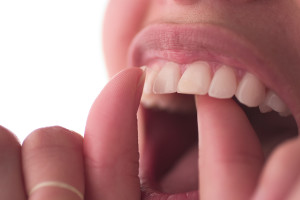 Flossing is an essential step in your home oral health routine because brushing alone is not enough to remove all bacteria and plaque. When you floss, you remove food particles, plaque and bacteria that get stuck between your teeth each time you eat. Knowing how to floss properly means you can remove the maximum amount of bacteria each time leading to healthier teeth and gums.
Flossing is an essential step in your home oral health routine because brushing alone is not enough to remove all bacteria and plaque. When you floss, you remove food particles, plaque and bacteria that get stuck between your teeth each time you eat. Knowing how to floss properly means you can remove the maximum amount of bacteria each time leading to healthier teeth and gums.
What happens when food gets stuck between teeth?
If the bacteria and plaque are not removed regularly between your teeth and in hard to reach places, then you could develop a whole range of oral health problems. Some of these include:
- Halitosis – bad breath
- Tooth decay
- Cavities
- Gingivitis
- Periodontal disease
- Tooth loss
- Abscesses
When food particles get stuck between your teeth, they release toxins, which can lead to tooth decay and gum disease. The food particles also produce lots of bacteria, which could cause infection. When the bacteria mix with your saliva, this chemical reaction produces plaque. This is a sticky, yellowish substance which can also cause tooth decay or gum disease.
Infection caused by poor oral hygiene is actually far more common than you probably realize. In fact, it affects up to 90 per cent of the adult population. However, you need not become the victim of oral infections. To prevent it from occurring, you merely have to follow a consistent and effective oral health routine at home.
Flossing is a key part of an effective home dental hygiene routine and should be done daily. As well as going through the motions, it is necessary that you floss properly employing the right technique and using the best available products.
Using the correct flossing technique
So you might be thinking that flossing correctly is just about slipping the floss between your teeth and shifting it back and forth a couple of time before moving onto the next space between the pearly whites. If you want to apply the correct flossing technique to get rid of as much “gunk” as you can in each session, then there are a few tips to be aware of:
- Start by taking a piece of floss that is 20-30 centimetres long and wind one end of the floss around your index finger and grasp it with your thumb.
- Leave about five centimetres from your index finger and wind the floss around the other index finger.
- Start at the back molars of the upper teeth and gently guide the floss into place between the teeth with a zigzagging type action.
- Pull the floss forwards with your index fingers so that the floss forms a “c” shape around the tooth.
- Gently move the floss up and down against the tooth several times.
- Once you have finished with one tooth, rewind the floss around your fingers so that a clean section of floss is ready to be used.
- Continue working the upper teeth from back to front and then do the same with the lower teeth.
Best way to floss around dental work
If you have braces or other dental work, then you need to be a little bit careful about your flossing technique. With care and the right method, you will not get floss stuck between braces, on wires or potentially dislodge bridges or prosthetics.
Some people with braces think that you can’t floss, but you can. In fact, people with dental work need to floss even more than others since it is more likely that you will have food stuck in and around your teeth.
- Be patient – flossing with dental work will take longer than for other people.
- Use waxed floss – you may even be able to find floss that is specially designed for people with dental work.
- Thread the floss under the wire in between teeth and then move it gently up and down around the tooth.
- Select a clean piece of floss and move onto the next tooth.
Knowing how to floss properly is essential as using the wrong technique can actually damage the sensitive gum tissue. By following this step of your dental routine once a day and then rinsing with mouthwash (without harsh chemicals!), you are ensuring that the chances of developing tooth decay and gum disease are much reduced. In additional to proper flossing, it is vital to know how to brush your teeth properly.